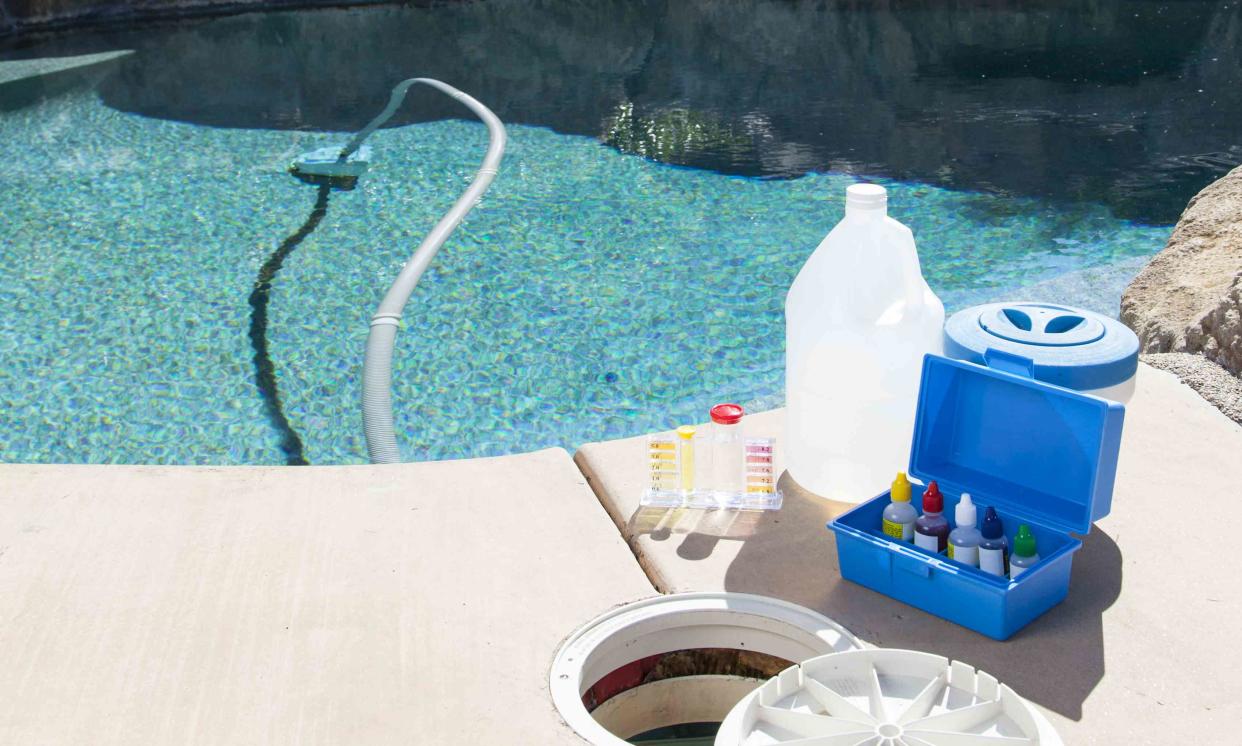How to Clean an Above-Ground Pool in 5 Easy Steps

iStock / Getty Images Plus
Cleaning an above-ground pool is not much different than cleaning any other type of body of water and is just as important. It is important to have a regular cleaning schedule for your pool to keep it looking clear and to limit the amount of downtime and costly repair needed.
Also, regularly cleaning your pool of debris will extend the life of your liner and save money in the long run. We've made cleaning your above-ground pool simple and broke it down into five easy steps you can do in a day.
How to Clean an Above-Ground Pool
Test and Balance the Chemicals
Testing and balancing the chemicals is the first step to see where your pool is at and how to keep it from turning green. Testing should be done for chlorine, pH, alkalinity, and calcium levels weekly.
Pro Tip
Add the chemicals needed after vacuuming to keep the water as still as possible for the cleaning.
Empty the Skimmer and Pump Motor Baskets
This should be done before and after the cleaning to limit the amount of debris that will get sucked into your filter and caught in the pump impeller.
To do this, turn the filter system off and close the system valves to not lose prime in the system. Then, open your pump housing and empty the basket. If done correctly you should see the water stay still when you open the housing, if not you will need to prime the pump beforehand.
Empty the skimmer basket and make sure the gasket in the pump housing is properly seated to prevent leaking. The next step is to open all the valves previously closed and turn the system back on.
Vacuum the Pool
To do this, assemble your vacuum and stretch the hose out. Once the hose is stretched out—making sure there are no kinks or twists—submerge the hose starting at the vacuum head and slowly work your way to the other end of the hose in a way that would allow the air in the hose to come out naturally.
Once at the end, you should see a small flow of water come out. Connect the hose to the skimmer body below the skimmer basket. Now you can proceed to vacuum.
Brush the Pool Walls, Floor and Waterline
Brushing the pool after skimming ensures that all the algae and other bacteria that are sticking to the walls or floors that the vacuum cannot get have been disturbed and are now released into the water for the filter to catch.
Empty the Baskets Again and Backwash the Filter
Empty baskets again and backwash the filter. This final step will empty the baskets that have been filled during vacuuming and clean the filter of the debris that was previously sucked up, leaving you with a clean filter system and pool.
Cost of Cleaning a Pool
The cost of cleaning a pool varies based on each specific pool's characteristics and location. For example, larger pools, geographic location, and length of season can all affect cost.
This also does not include repairs and chemicals which vary significantly based on what type of pool and filter system are being used.
Hiring a Pro vs. DIY Pool Cleaning
Whether you are a new pool owner or have been around one your entire life, there are pros and cons to hiring a pro to clean your pool or do it yourself. Hiring a pro is the easiest, but more expensive option. The main benefit of hiring a pro is that you don’t have to worry about emptying the baskets, testing and balancing chemicals, or even backwashing. But, this convenience will cost you and the price given does not include repairs to the pool itself.
If you choose to do DIY pool cleaning, you can save a lot of money because you will only have to pay for chemicals. But, the pool must be regularly cleaned and balanced otherwise you could cause a potentially expensive repair. However, with proper brushing, vacuuming, testing, and balancing, taking care of your own pool can be very rewarding.
Frequently Asked Questions
How do I get my above ground pool clean again?
When your pool turns cloudy or green, the first step is to test for all chemicals and adjust. This will tell you what the probable cause could be and how to remedy it. Then, after testing the water, backwash the pool at least once a day which will keep the filter working as efficiently as possible. Most pools will clear up within a few days.
How to clean an above ground pool that has been sitting for months?
Since the pool has been sitting for months, there has been sufficient time for the pool to turn green and develop a scum line around the pool. The best method to clean a pool like this varies based on the degree of debris in the pool. For extreme cases, the pool must be drained, all leaves and debris shoveled out, then the pool should be acid washed and refilled. In most cases however, if you remove all the debris, scrub the water line, brush the pool, shock with chlorine, and keep the filter running 24 hours a day with daily backwashes, the pool should clear up in a few days.
What chemicals do I need to keep my above ground pool clean?
There are four main chemical levels to maintain for any pool; chlorine, pH, alkalinity, and calcium. The chemicals needed to adjust these are chlorine tablets, pH plus (soda ash), sodium bicarbonate (alkalinity), and calcium flakes.
Read the original article on The Spruce.

